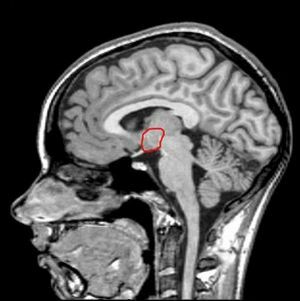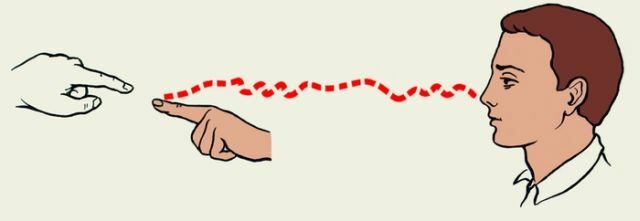 Hypothalamic syndrome is a disease that includes the complex of disorders of a vegetative, endocrine, metabolic and trophic nature.
Hypothalamic syndrome is a disease that includes the complex of disorders of a vegetative, endocrine, metabolic and trophic nature.
This syndrome is directly associated with any damage to the hypothalamus, which is why it develops.
It is worth noting the fact that the indispensable element of this syndrome is neuroendocrine disorders.
In ICD-10, the hypothalamic syndrome received code E23.3, indicating hypothalamic dysfunction, which was not classified elsewhere.
Features of this disease is the extensive impact on various body systems, which in turn leads to a variety of symptoms.
The key factor for the emergence of this syndrome is damage to the hypothalamus, and the damage can be both physical and clinical.
Content
- reasons
- syndrome Classification of Diseases
- Symptoms and signs of the syndrome
- Screening and diagnosis
- hypothalamic syndrome of puberty
- disease
- Treatment Prognosis and complications
- Preventive measures
reasons
syndrome reasons for which an hypothalamic syndrome enough in the first place can be identified the following:
- increased pressure on the hypothalamus due to excess fluid in the skull;
- direct physical damage due to traumatic brain injury;
- chronic infectious diseases;
- intoxication of the body( acute or chronic).
 A dangerous subspecies of brain tumors - astrocytoma of the brain. Her varieties, symptoms and methods of removal.
A dangerous subspecies of brain tumors - astrocytoma of the brain. Her varieties, symptoms and methods of removal. Is the nervous system exhausted and are you on the verge of collapse? Learn how to treat astheno neurotic syndrome and how to hedge against its relapse in the future.
Classification of the disease
Due to the variety of causes causing this syndrome, and a very diverse symptomatology, there is a very detailed classification of the disease.
Depending on the cause of the syndrome:
- of a primary nature( caused by trauma or neuroinfection);
- secondary nature( caused due to constitutional obesity);
- of mixed character.
Based on the clinical manifestations of the hypothalamic syndrome happens:
- vegetative form;
- is a neurotrophic form;
- neuromuscular form;
- pseudo-neurasthenic form;
- neuroendocrine form;
- is a psychopathological form.
With this syndrome is also associated:
- with diencephalic epilepsy;
- thermoregulation disorder;
- disorder of motivation and drives;
- neuroendocrine metabolic disorders.
Statistics also showed that in more than 27% of cases this syndrome manifests itself as a metabolic disturbance. Even more rarely, namely, in only 10% of cases of the disease, the syndrome manifests itself as a neuromuscular disorder.
Finally, more than 20% of all cases of the syndrome manifests itself as a violation of thermoregulation.
The classification also includes options that characterize the severity of the disease. On this basis, distinguishes:
- light form;
- average shape;
- heavy form.
There is also a classification that relies on the nature of the development of disease:
- recurrent;
- regressing;
- stable;
- progressive.
It should also be noted one characteristic feature: during puberty of a young man or girl, the syndrome can, how to speed up, and on the contrary to stop puberty.

In the photo, the hypothalamic syndrome and its forms
Symptoms and signs of the
syndrome Symptoms and signs that indicate a hypothalamic syndrome are quite numerous.
Armed with them, it is possible to diagnose this or that form of hypothalamic syndrome. The same symptomatology is classified based on the clinical manifestations of this syndrome. Therefore, isolates:
- Symptoms of metabolic disorders: Change in body weight( not only weight gain, but also its decrease).The appearance of so-called striae, characteristic stretch marks in the area of tender skin areas: thighs, armpits, back, buttocks. The characteristic sharp smell of perspiration is traced. Some parameters in blood tests increase. For example, the level of glucose.
- Symptoms associated with the vascular system: Stability of mood swings, characteristic mood reduction and depression. Characteristic insomnia and drowsiness.
General fatigue. Severe headaches. Increased appetite and thirst. Reduced or increased sex drive. - Symptoms in violation of thermoregulation: Sudden jumps in body temperature up to 40 degrees. Constant feeling of chilliness. Intolerance of low temperatures and drafts.
Diagnosis and diagnosis of
To diagnostic methods for the definition of the syndrome, there are many different variations, since the symptomatology affects most of the body systems.
For the productive diagnosis of the syndrome use:
- Magnetic resonance imaging of the pituitary gland or the entire brain.

- Biochemical and hormonal blood tests.
- ultrasound of the liver. This method is effective in the form associated with a metabolic disorder.
- Ultrasound of the thyroid gland in conjunction with blood tests provides an effective and very indicative result in diagnosis.
- Study of the adrenal glands. A technique is used to determine the disease from the missing hormones of the adrenal glands in the blood.
- Various methods of heart examination. Often when the hypothalamic syndrome, the heart is subject to a painful disorder.
Hypothalamic syndrome of pubertal period
Hypothalamic syndrome of the pubertal period is a kind of hypothalamic syndrome in children and adolescents at pubertal age.
A characteristic feature of of this syndrome is the inability to accurately determine its cause, as well as the connection with the problems of hormonal activity of the adrenal glands.
Often, with such a variety, there is a uniform obesity of the child, complaints of headache, fatigue.
A characteristic feature of for adolescents is the premature appearance of secondary sexual characteristics in girls and the effeminate face that has not been covered with bristles for a long time, even after full puberty in boys.
Neurotic abnormalities in the form of neuroses and depressions are also not rare.
Treatment of the disease
 Treatment of the hypothalamic syndrome is almost always successful, if it was possible to exclude the very cause of the disease , be it an infection or a physical deviation.
Treatment of the hypothalamic syndrome is almost always successful, if it was possible to exclude the very cause of the disease , be it an infection or a physical deviation.
So, the course of treatment is formed entirely with the participation of a neurologist and an endocrinologist who select medicines that can completely stop all the deviations and disorders associated with the hypothalamus systems of the body.
Prognosis and Complications of
Complications that the hypothalamic syndrome can give are very serious.
With frequent repetition and intensification of a number of symptoms, abnormalities can occur in a number of body systems.
Preventative measures
Since the various crises inherent in the hypothalamic syndrome occur mainly at a certain time and are associated with changes in weather conditions, the only preventive methods can only be to prevent this syndrome by taking sedatives.
Also it is necessary to carry out with care the work connected with threat of a traumatism of a head.



